
STEPAN FERMENTATION CHEMICALS
By 1964, Bob’s career had taken another move upward, when he accepted a position as the Director of Research and Development for Stepan Fermentation Chemicals, Inc. in Keyport, NJ. He was 45 years old and father of eight children. Here Bob guided a research program in organic acid fermentation. He also directed the writing of operating manuals for plant and lab personnel (information from Robert’s resume).
Alfred C.Stepan, jr. bought the Keyport plant. Today, Stepan is thriving and has plants around the world. From their website:
“Stepan is a global specialty and intermediate chemical manufacturer that has been serving a broad range of industries since 1932. Today, Stepan is a $2 billion revenue company and our continued success is driven by the passion and commitment of our 2,200 employees around the world. The entrepreneurial spirit of our founder, Alfred C. Stepan Jr., is still present as we continue to seek and develop solutions for our customers….
Stepan’s global research and development team of 230 scientists brings innovative solutions to the market and work alongside our customers to help them be successful in their markets and be more efficient in delivery of their products and technologies. As we deliver solutions, we will expand our product portfolio with diverse chemistries that benefit the environment, promote human well-being, and meet the needs of a growing population. Stepan is proud that more than 70 percent of our products offer energy-related savings, biorenewability or reduced environmental impact.”
Bob continued his work begun at Bzura when working for Stepan, making citric acid cheaply. Citric acid is used as a flavoring and preservative in many foods, especially soft drinks and candy. At the time Bob was making it, it was used in the powdered drink, FUNNY FACE, which was a competitor to Kool-Aid. A quick online search for FUNNY FACE, shows it’s standing in the pop culture of the times. Each flavor was named for a quirky fictional character and the company developed various tchotchkes around these characters. the drink was originally swweetened with calcium cyclamate, which was later found to cause cancer in lab rats, for the FDA banned its use in 1969. Info. from Todd Frye’s POP-CULT.com.
His work can be found listed on google scholar (there are 3 citations):89.Agnello LA, Kieber RJ (1961) Citric acid. Ind Eng Chem 53 253–258 Google Scholar
Then there was the Cuban revolution! The final battle, The Battle of Santa Clara, led by Che Guevera in December 1958 enabled the new revolutionary government, led by Fidel Castro to depose U. S. backed, military dictator, Fulgencio Bartisto. Five years later, in 1964 Maj Che Guevara, then the Cuban Minister of Industry, was attempting to industrialize the country. Back in NJ, the Stepan Chemical Co. began acquiring the molasses from sugar cane in Cuba for the citric acid fermentation Bob was producing. Bob went to Cuba for the company. It seemed he loved Cuba, saying it was a most beautiful country. the molassses in cuba was grown from sugar cane…
Unfortunately, Che’s plans for industrialization did not work out. And Stepan was unable to procure another source of molasses made from sugar cane rather than sugar beets (as it was in the US).
As you can see, the company did not do well, and in the process of reshuffling, they told Bob that he could be transferred to the Chicago office, or to India. Neither of these situations appealed to him. He felt he was living his dream and he loved being close to the water. Also, he felt that since, he was so successful, he’d be able to get a new job quite easily, since his previous jobs were not difficult to acquire.
See Part 6 for Robert’s complete publication list and details.
From the history of the Stepan Company, here is a paragraph about the time Robert worked there: In 1964 Stepan made a decision to enter the rich citric acid market, but rather than use sugar beets as a base, he concentrated on making citric acid from blackstrap molasses at half the price. This significant effort cost the company a great deal in manpower, capital, and tons of blackstrap molasses. By the time Stepan realized that his venture was not going to be profitable, the company had lost more than $2.5 million in 1967, and per-share profits had declined precipitously from $1.67 in 1964 to a mere 12 cents by 1967. Incredibly, Stepan, Jr., turned the company around immediately. The owner refocused on the production of specialty chemicals for the consumer products industry; concluded an agreement with a British firm to become the exclusive manufacturer and marketer of a versatile new urethane foam; developed a chemical additive that doubled the life of an ordinary pair of blue jeans; and expanded the firm’s research facility in Maywood, New Jersey, so that it could become one of the leaders in the field of aromatic chemicals. The turnaround was so dramatic that by the end of the decade sales amounted to over $25 million and earnings increased to an all-time high of $1.69 per share
NAVESINK RIVER ROAD
1964 LOCUST NJ The family was growing and Bob’s career was on the rise. They moved out of the cramped quarters of the house in Rumson to nearby Locust. Not sure why this place was called Locust, but there was a plethora of black Locust trees in the area.
Note: Much of the following information, is from the Middletown Township NJ website. In particular, the publication on the Locust Historic District. I, and my family are grateful to the authors and historians for providing background and context to this formative time of our lives.

928 Navesink River Road, is listed as Site #8 in the LOCUST HISTORICAL DISTRICT publication. The Historic Name is the L.H. Amy House. In 1881 Henry Amy, a banker from New York, bought the property. The original house built by Eliza and Charles Yallalee five or so years previously was sold to George W. Kuyper, who moved it next door on his property that would later be owned by the White. “According to the Red Bank Register, Louis Amy then spent $10,000 in 1900 to build his new 20- room mansion, which, because of its sophistification, is believed to have been designed by a New York architect.” Since I know very little about architectural details and language, and because the beautiful structure of the house has changed very little in its 125 year history. I will quote the descriptive paragraph for the house in its entirety:
This substantial residence, which was constructed by Nehemiah Brower, displays many characteristics of the Queen Anne style, most predominantly the steeply hipped roof with four lower cross gables that project on all four sides. In addition, the roof is busy with hipped dormers and two chimneys. The gable of the street facadeis placed asymmetrically and projectslike a tower. Very characteristic is the veranda which begins on the east end and extends across the width of the riverfront side of the house. The house is shingled and has a brick foundation.
Built between 1873 and 1880, the barn is a two-story structure with a polygonal cupola. The building is capped by a jerkinhead gable with eaves brackets, and rests on a peanut stone foundation. Attached to is is a one-story structure with small dormer windows; this may have been quarters for the groomsman. Nearby is a small early 20th century pumphouse.
During the years the Kiebers lived in Locust, they were visited in the summer by Rev. E. Paul Amy,(b. 1898) a Jesuit priest at St. Francis College in NY. Turns out, he was a son of L. Henry Amy, who bought the property in 1881. He told us stories of living there, including that he and his brothers built the boathouse we loved so dearly, though we never stored any boats in it. Marie remembers him telling us that the carport, which extended over the circular driveway from the front porch, could be accessed by a doorway in the upstairs hall. This was used to board the sled (stored of course, in the carriage house!) drawn by horses that they used to go to Sunday Mass when it snowed.
Navesink River Road was part of the historic MINISINK TRAIL used by the Lenni Lenape tribes as delineated on the 1747 James Alexander Map. It connected the Navesink Lenape communities along the river to the Lenape Minsis, at the Deleware Water Gap. In 2022 a marker was erected at the top of the road. Please click on the link provided for a reference. Also, this area was extensively researched by historian Paul Boyd, who wrote a Ph.d dissertation on the area for Rutgers University. If you are able to obtain a copy of this dissertation, please send me a copy. Pretty please. The salt water estuary river is 1/2 mile wide and 5 miles long, from the Sea Bright to Red Bank and not much more than 8 feet deep at low tide.
Fr. Amy had told us a story about a ferry to NYC that docked on our beach. There was a post in the sand that had been used to tie a boat to…and I alway wondered about that ferry, I finally found some documentation on the Middletown Township page online. Locust was an eighteenth century farming and fishing village. The”Newesingh lands” had been bought from the Lenape Newesingh Sachem, Popomora in 1664 by a group of twelve men, including George Grover., one of the earliest settlers. However, there were no permanent settlers until David Burdge, from Hempstead, Long Island bought 375 acrres or virtually all of what constitutes Locust today in 1715.The river (including Clay Pit Creek) became renowned for its shellfish, including the Navesink oyster, which was a delicacy in the nineteenth century. Boatmen would travel with their haul to NYC, selling the shellfish to restaurants. In the 1850s, Joseph Mount built a large dock at Locust Point (What we knew as Annarella’s beach) for the faster steamboats to bring the produce into the city. Within ten years, rich New Yorkers were building summer homes in Locust. The transformation of the farming /fishing village into a seaside resort began! The question remains… was the piling at the Kiebers beach, mount’s steamboat on the navesink beach used for that or for another steamboat-ferry? And perhaps one day, The Navesink Maritime Org. will reproduce a shallow draft coastal side wheeler….a brand new Navesink Steamer. Today you can take a ride on a steamer, THE NAVESINK QUEEN which is docked in Atlantic Highlands. And, if you really want to delve, there is a pictorial book written in 1966 by George H. Moss, Steamboat to the Shore, a pictorial history of the steamboat era in Monmouth County, NJ.
 For nerdy family members, interested in how property values change over time: The assessed value in 1979 was113, 900 and the property taxes then were $4,740.63. It sold in 1996 for $525,000. According to Zillow, the wood frame house encompasses 7,942 sq. ft. of living space . Its estimate in 2023 was $3,170,300. The photo article at right is from the Red Bank Register. It sits at the base of a long gravel drive, on a hill close to the Locust Point, and overlooks the beautiful Navesink River. The property is 1.61 acre, including the beachfront.
For nerdy family members, interested in how property values change over time: The assessed value in 1979 was113, 900 and the property taxes then were $4,740.63. It sold in 1996 for $525,000. According to Zillow, the wood frame house encompasses 7,942 sq. ft. of living space . Its estimate in 2023 was $3,170,300. The photo article at right is from the Red Bank Register. It sits at the base of a long gravel drive, on a hill close to the Locust Point, and overlooks the beautiful Navesink River. The property is 1.61 acre, including the beachfront.
Five year old Sue remembers being soooo excited about the new house. It was so big and the yard was huge. There was the river and the fun trees. She recounted climbing the large copper beech tree on the first day in Locust, falling out and spraining her arm.
Bob was an incredible handyman and one of the first jobs in the new house was to close off the dumb waiter with velvet ropes between the first and second floors. He was afraid one of the kids would fall into it and one of us probably would have!
After that, he wallpapered Marie and Carolyn’s bedroom no heat above the Cold Room with a pretty blue french flower cart patterned paper. Dad also remodeled the Cold room so that it became usable, even with the ping pong table in it. He wallpapered and painted the apartment beside the large garage/ carriage house. Carolyn had her first indoor painting lesson when he taught her how to paint what would become Gramma Lasecki’s living room when she moved to Locust. Carolyn also remembers the summer after eighth grade, painting the sprawling back porch that overlooked the Navesink River as Robert rebuilt the steps from the porch to the lawn,with brick and concrete. He paid us kids a nickel a brick, which we’d find in the sand of mud flat at low tide and carry up to the porch. from river up the hill. Dad wanted to fill up the back porch stairs to make them last longer and become super sturdy. He also made steps to river — about four long flights — and put in a concrete and slate patio outside of the Breakfast room. On the large third floor, Bob refinished a bedroom, (teaching Marie how to wallpaper and she would eventually sleep up there) which Greg would sleep in when he returned from His service in Germany during the Viet Nam War. and made a bathroom, master bathroom.
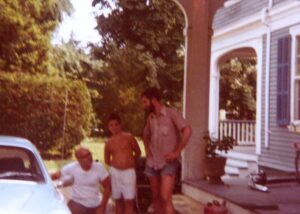
We all learned from him how to fix, repair, and remodel. Of course, these were also part of our summer daily chores, and school year weekend chores. We were expected to work for an hour per day in the summer, but several hours on the weekends during the school year. In that way, we all contributed to the family life and felt a part of the fabric of life.
The boys watched as every weekend, Dad would be working on one or the other car. In those days, cars did not have computers and were much easier to understand and repair
The Gardens For Tommy’s 5th birthday, Bob bought a Pear tree …and then another for his 6th birthday. Bob was an avid plantsman, which passed on to many of his children and grandchildren. He came from 200 years of peasants! Growing things was in his blood. And he developed the gardens surrounding the Locust house, teaching the children not only how to identify and pull weeds, when to trim iris back, pruning of fruit trees, creating wires for growing grapes, etc. Dad grafting and growing roses….our life with plants!
The kitchen:any Cake for birthday …bob always said make mine BIG…greg always wanted chocolate… girls all learned to cook and iron, dust, babysit, weed the gardens
hristmas time hiding the anise cookie dough,,,kids would try to find it and snitch some…..speckled pot
His Mom, continued to make the famous Ruhland Baked Beans, and the Bavarian Anise cookies that came over with the family from Germany.
any Cake for birthday …bob always said make mine BIG name days…snitching…peanut butter…Baked beans on saturdays
After dinner chats..Bob–socratic method after dinner…he would ask us what do you think about his…he would ask what books to read…forbad Marie from tropical diseases book…carolyn from Kant…Rabi couldn’t read Camus…
The Mud Room
The Breakfast room
The Kiebers met an old friend from nursing school in Ann Arbor. Who would become their lifetime friends, Mary and Doug Vanderbilt at Holy Cross. Pris was pregnant with Rabi at the time and Mary was carrying Kippie. Both had recently moved into the area and both women had known each other in nursing school in ann Arbor. Both shared their Catholic faith and would go on to have many children, who became cousins of the heart with one another.
Mary and Doug, Bob and Pris played Bridge on Friday evenings in the Breakfast Room. Marie made cake sometimes for them. Tommy bartended for them. and I remember the exasperation of the partners with each other. Mom always had a terrible memory and Dad a superlative one. That did not make for good bridge partners!
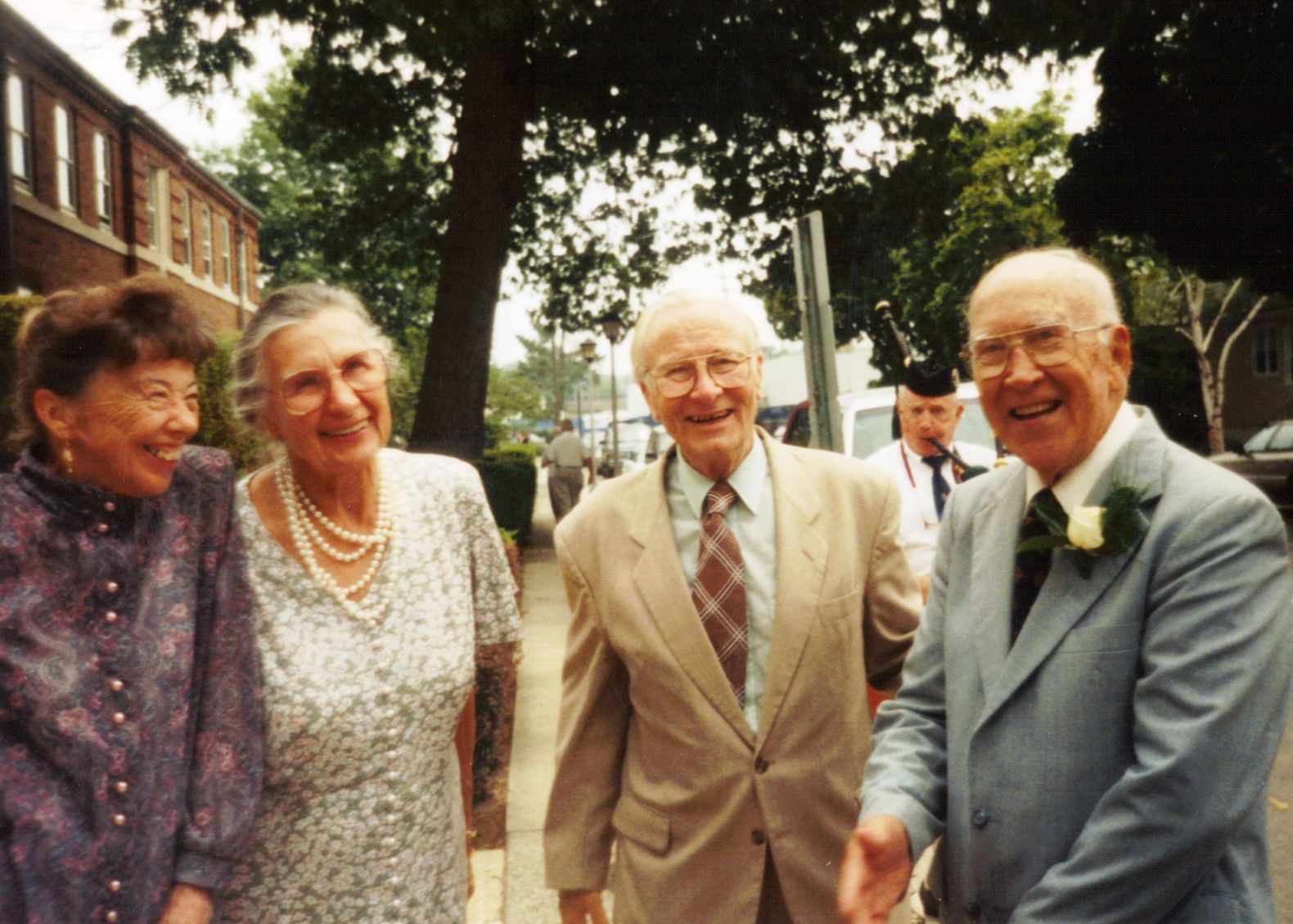
the Front Parlor
The Living Room
The Dining Room
The Butler’s Pantry
The room to the far left of the first floor (looking at the back of the house as in the photo above) was called the Cold Room because it didn’t have any heat. Marie and Carol’s bedroom upstairs, over the Cold Room also did not have heat. Remember, originally this was a summer house. Hole in cold room floor from bob and joe…Barb plant blamed christmas time hiding the anise cookie dough,,,kids would try to find it and snitch some…..speckled pot
The third floor was a full floor, with an attic above it available via pull down stairs. The third floor, which was at one time, probably the servants’ quarters, consisted of three bedrooms, a kitchen, a fan room, and a bathroom. Two of the bedrooms were used as bedrooms and one remained a playroom. The kids played library in there, and other make- believe sort of activities. Carolyn played the scientist and had her chemistry or mineralogy labs set up at different times.
my shed…
bob and joe lit gas on fire in plant shed…and started it on fire
joe fell through septic tank next to his garden and he fell in when he stepped on the rock and it cracked and break he fell and was able to climb out
Billy beatty and greg walking outside in the built in gutters shooting the racoons on the roof….climbing up the side of the house….greg had flashlight….greg was still in high school….1968 or so. Raccoons in the attic…Billy beatty told Dad to use peanut butter…they 13 raccoons.
In Locust there was room and plenty of adventure for the large, boisterous family. I’ll recount just a few of the more memorable occasions at RIVERHAVEN — as Priscilla dubbed it. It became a welcome center for the kids friends….
THE RIVER
 St. Agnes Church Rev. Michael J.. Lease (later Monseignor Lease) was the pastor.
St. Agnes Church Rev. Michael J.. Lease (later Monseignor Lease) was the pastor.
choir at st aggs
In 2013, the parish merged with Our Lady of Perpetual Help in Highlands to form one parish, OLPH St.Agnes Parish.
ST. Agnes School Bob and Pris wanted their children to continue attending Holy Cross School in Rumson. After all, it was actually closer than St. Agnes in Atlantic Highlands. However, because of where they now lived, they were officially in St. Agnes Parish and were not allowed to continue at Holy Cross. We finished out the year and began attending St. Agnes. I was the eldest still in grade school and I moved into sixth grade.
Greg had begun high school at Christian Brothers Academy in Lincroft. Marie was going into 8th grade, so she could finish her elementary years at Holy Cross and then begin high school at Mater Dei in New Monmouth.
The Mother Teresa Regional School complex, formerly known as St. Agnes School, closed in 2016.
St. Agnes Thrift Shop The St. Agnes Thrift Shop, which was founded in 1969 inside a century-old, three-story colonial-style mansion, has a gated entryway on Avenue D. (Two River Times) The House of Guise blog, called it the “Holy Grail of Thrift Shops” and “it’s liek the craziest estate sale you’ve ever been to.” As of nov. 2023, the Thrift Shop was still opererating and there were still regular Masses scheduled at St. Agnes. According to the Borough of Highlands online page: “In 1997 Rev. John M. Dobrosky purchased the house on the corner of Miller and Navesink Avenue, which is was then known as the St. Jude Thrift Shop. In September 2017, the property was sold to the Borough of Highlands as the site for their future Borough Hall.”
APR 1966 Bob’s last child was born and his mother-in-law came to help out the family.
worst memory of marie: going down to the river to read the awful summer reading list….from Mater Dei
Locust library — beatles yoga..
UNEMPLOYED!
Unfortunately, in 1967, when Robert was 47 years old, he found himself unemployed with 9 dependent children. He always thought the children needed a stable place to grow up and he did not want to uproot them again.
Priscilla (45 yrs. old) took a refresher course for Operating Room nurses which there was a great need at the time. Soon thereaafter, she found employment at Riverview Hospital for a salary of $9,000.
The family never went on welfare…he did not want a handout
The family never wasted food. When they lived in Locust there was a jar a grape jelly that had gone moldy. Bob said We don’t waste food and he took it and tried to turn it into wine. Let’s just say, this was one experiment that did not work out very well.
Desperate to bring some money into the family, Robert got a job with a road crew, digging ditches. He quicly became wise to the New Jersey MAFIA bosses and left that job soon thereafter.
The Kiebers met an old friend from nursing school in Ann Arbor. Who would become their lifetime friends, Mary and Doug Vanderbilt at Holy Cross. Pris was pregnant with Rabi at the time and Mary was carrying Kippie. Both had recently moved into the area and both women had known each other in nursing school in ann Arbor. Both shared their Catholic faith and would go on to have many children, who became cousins of the heart with one another.
Mary and Doug, Bob and Pris played Bridge on Friday evenings. Marie made cake sometimes for them. Tommy bartended for them. and I remember the exasperation of the partners with each other. Mom always had a terrible memory and Dad a superlative one. That did not make for good bridge partners!
Games were a big part of our growing up. Long rounds of Monopoly, Scrabble, Parcheesi.Card games of all sorts…..and lots of outdoor games and sports. Playing football on the lawn.
He played 3 handed pinochle with Gramma lasecki…definitely there when greg was in hs…because he used to sneak in…and roll the car down the drive
cheese
Wonder Bread Outlet
1968 — Greg grad. hs 1968 and explorer in high school and Carol graduates 8th grade.
1968 -1969 — Bob was 50 years old and Professor of Biology and Chair of the Dept. Georgian Court College, Lakewood, NJ. He taught courses in Cell Physiology, Histology, and Methods in Biology Education to the gals in this Catholic Women’s College. He also revised and modernised the curriculum.
CHEATER: One day Doc was giving a test and he noticed a girl staring at her thigh, so he went over to see and she had something written on her leg. He called her on it. The young woman filed a complaint. And Bob heard from the administration who were mad at him and said,”You shouldn’t have been looking at her thigh.” He was of course, filled with righteous anger at the injustice that the female student would get away with cheating. So the admin. found a nun to take over Bob’s position and, even though the students wrote a petition to protest, they let him go.
THE HUNT The Haskells
BODMAN PARK folk baseball games
NAVESINK LIBRARY
POLLY POND –every time dave smells creosote, he thinks of the dock at pollys he was a loner as a kid
NURSING HOME bob and joe sleeping…they had a job painted at atl highlands…finished in quicly…and then closed the door of the room and went to sleep
dave washed the cedar shake shingles with a paint brush,,,,dave drank kerosene
daves room locust…with bob a joe…screech owl…..he kept shoes by his bed because they both snored
dave slept in attC after greg when dave was in high school….he worked at night until 4 in morning from there rode bike home schwinn super sport no handed charlie daniels band …transistor….that dave inherited from greg at long johns and bahrs 15 – 20 min ride maybe
In 1971, Bob was 53 years old when he and Pris packed up the station wagon with the seven children, still living at home (Carolyn was the eldest, a senior in high school) and drove to Buffalo, NY for a Kieber family reunion at his brother, Fr. Lavern Kieber’s parish lawn in Bowmansville, NY. Sacred Heart Church is about 20 minutes from downtown Buffalo NY.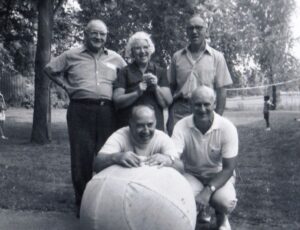
1970-1972 Design Engineer at A.J. Celiano, Inc., Crawford, NJ where he designed, purchased and supervised installation of air conditioning and heating systems in many of the Catholic Churches in northern New Jersey. Though certainly competent for the work and grateful to be working — his friend from St. Agnes, Mr. Greg Schilling from Red Coach Lane, had gotten him the position. He wasn’t very happy doing that and realised that, in his heart he was a teacher.
MATER DEI HIGH SCHOOL
1972 – Bob, unable to find other suitable employment, and having the important self-realization that he was a natural teacher, accepted a position at Mater Dei High School in New Monmouth, NJ. His salary was about $10,000 per annum. There he taught Biology for all levels and became known as “Doc.” He also inspired many young people while on the faculty of Mater Dei where he remained faculty member for eight years.
Marie and Carolyn graduated before Bob took a faculty position. Seven of Bob’s kids attended Mater Dei High School in New Monmouth,NJ after graduating from St. Agnes.

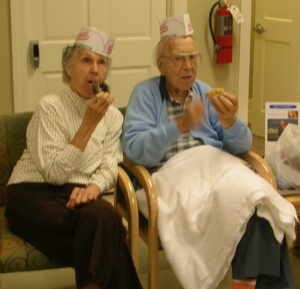
Robert’s third son, Bob’s first day alone with his his Dad was during brother Dave’s football game in freshman year of HS (Mater Dei) Bob sn. and Bob jr. went to a donut shop and young Bob was so freaked that he got a glazed even though his Dad said he could order any donut he wanted! Donuts were “a thing” in the family — remember Bob worked at Freddie’s Donuts and Parkside Candy as a teenager –until Robert’s death as the photo to the right attests.
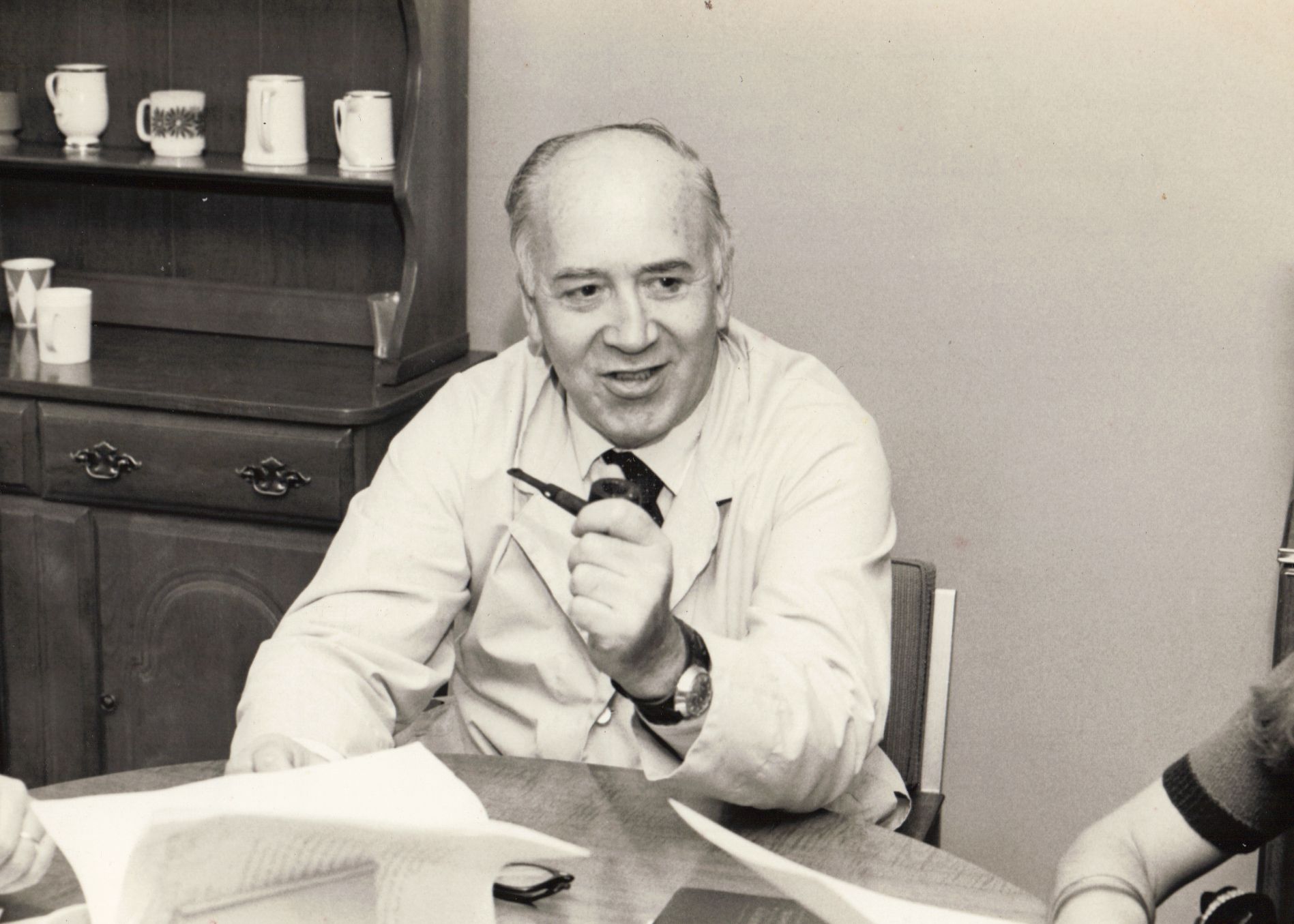 Lackawanna Steel in Buffalo experienced was a hotbed for labor unrest and was workers took part of a nationwide steel strike in Fall 1919. The Catholic Church was a major player for organizing labor in Buffalo as elsewhere. That was the labor arena Bob grew up with. Bob began to lobby his colleagues at Mater Dei for a Union. Though their salaries would not increase, he convinced them that the “perks” were — things like health insurance, sick leave, retirement packages. And, furthermore, that these perks were, in fact, money added to their salary.
Lackawanna Steel in Buffalo experienced was a hotbed for labor unrest and was workers took part of a nationwide steel strike in Fall 1919. The Catholic Church was a major player for organizing labor in Buffalo as elsewhere. That was the labor arena Bob grew up with. Bob began to lobby his colleagues at Mater Dei for a Union. Though their salaries would not increase, he convinced them that the “perks” were — things like health insurance, sick leave, retirement packages. And, furthermore, that these perks were, in fact, money added to their salary.
JUD Y COLLINS….concert he went to a basketball game with Marie at Mater Dei (Marie graduated in 1969)
In 1973, Greg returned from his mandatory service time in the Air Force where he drove large trucks in Germany. As he was walking down the driveway, the younger boys saw him and asked if he were looking for George, the renter in the carriage house apartment. They didn’t recognize their own brother!
At first greg stayed in the west bedroom on the third floor. He got a job aat a local supermarket, Foodtown and in 1975 returned to college, this time at Rutgers University in New Brunswick NJ. Eventually, George moved out of the carriage house and Greg moved in to that apartment. He lived there until 1976 when he got an apartment in New Brunswick. Four years later, he met the love of his life, Dr. Anne Etgen.
Old friends, Doug and MAry Vanderbilt with Bob and Pris in 1995
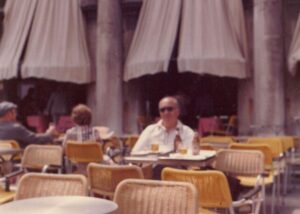
1973 25th wedding anniversary. All of the children were there, except for Carolyn. She was living at Florida Institute of Technology in Jensen Beach, FL., working in the kitchen at the time. She was also sick in bed — in the dormitory with a fever and cold. The kids took up a collection from their various jobs and gave their parents a trip to Europe for their anniversary
1976 Grandma Lasecki became ill. she had an enlarged spleen and the doc wanted to do a bone biopsy to see if it was leukemia. Gramma would do no such thing. She was ready to die and join her beloved Walter in heaven. Her daughter and several grandchildren were there during her last days.
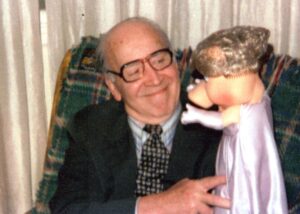 1979 Bob never lost his sense of humor, which by now was a family trait. The first Muppet film came out and Bob fell in love with a central character, Miss Piggy. One of his kids gave him a Miss Piggy puppet, which stayed around the rest of his life.
1979 Bob never lost his sense of humor, which by now was a family trait. The first Muppet film came out and Bob fell in love with a central character, Miss Piggy. One of his kids gave him a Miss Piggy puppet, which stayed around the rest of his life.

Another milestone in 1978 was the birth of Bob’s first grandchild, Christine.
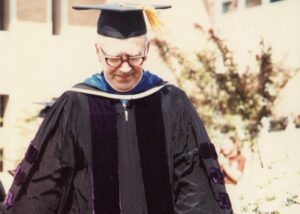 1980 — Joe was the last Kieber child to graduate from Mater Dei High School. He did so in style, as the Valedictorian of his class and with Dad processing, also in academic regalia. Youngest child, Tommy graduated from St. Agnes and would continue his education at Trumansburg High School.
1980 — Joe was the last Kieber child to graduate from Mater Dei High School. He did so in style, as the Valedictorian of his class and with Dad processing, also in academic regalia. Youngest child, Tommy graduated from St. Agnes and would continue his education at Trumansburg High School.
In 2022, Mater Dei (then Mater Dei Prep) closed due to a dramatic decline in enrollment.
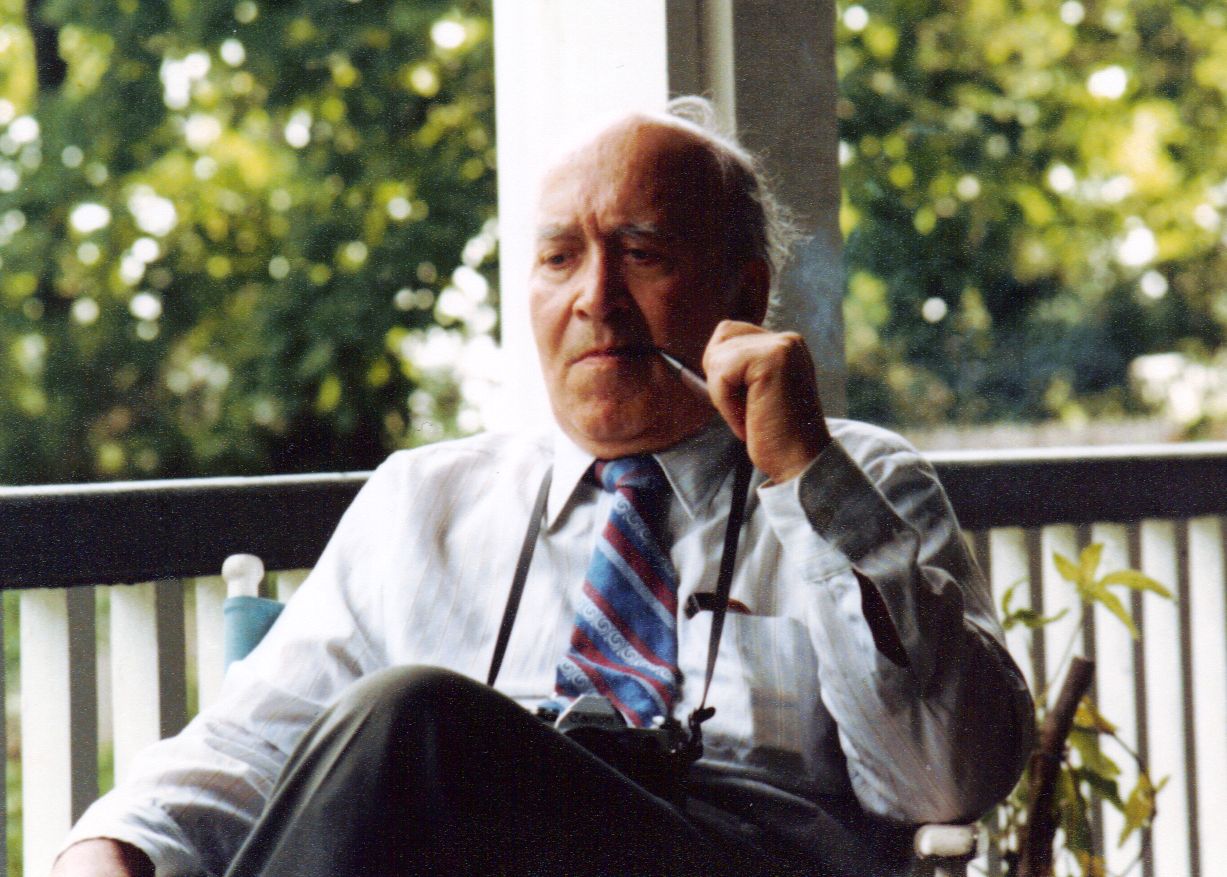
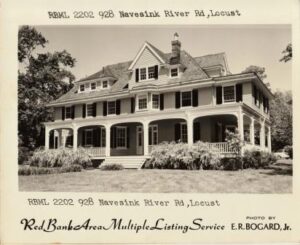
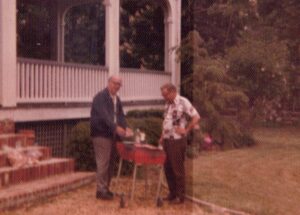
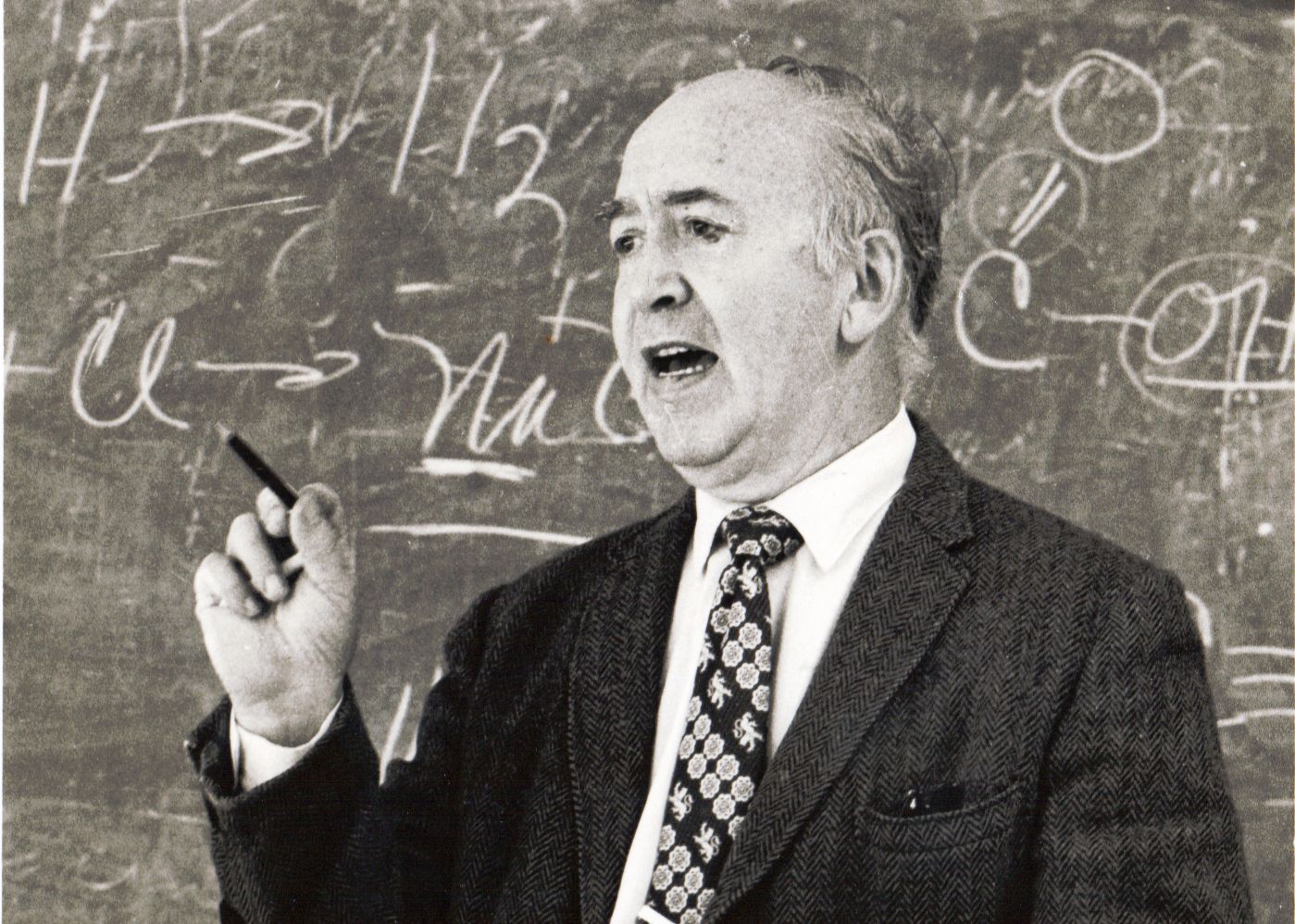
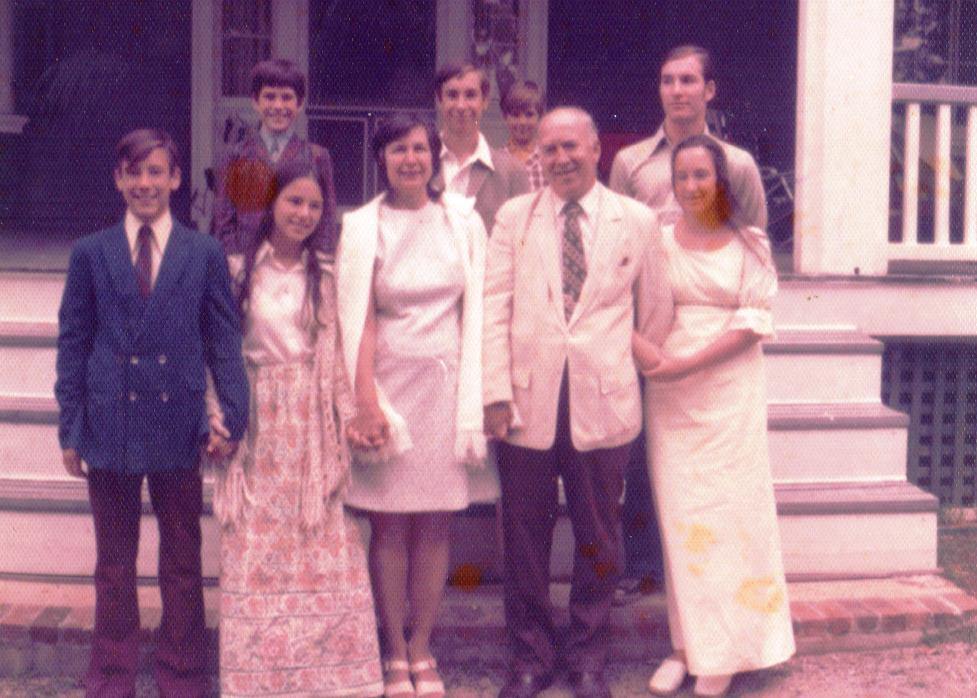
Leave a Reply